Table of contents
Background: Background introduction of Cellual.
Links: Related links.
What is Cellula?
Recommended reason: Why Cellula is recommended
Rewards: Rewards for recent activities.
Game interface introduction: Introduce each interface of the game and what they do.
Introduction to game values: some introduction to game values to give you a clear idea.
Preparation: Preliminary preparation work.
Detailed explanation of the gameplay: even novices can easily get started.
Game Strategy: Purchasing: Strategies for purchasing stores in BitLife.
Game strategy: self-generation: self-generation of BitLife strategy
Economic model.
Q&A: Frequently asked questions and answers.
References
risk warning
Contact the author.
background
Cellula is a project incubated in the sixth season of Binance Labs.
Financing background: Cellula, the only full-chain AI game invested by Binance Labs in the sixth phase, completed a $2 million Pre-Seed round of financing, led by SevenX Ventures and OKX Ventures, with participation from Mask Network, Foresight Ventures and others.
The first game "Game of Life" was launched on the mainnet on April 15, and airdrop activities were carried out in cooperation with BNB Chain. In addition, the brand will be upgraded, the product matrix and game reward mechanism will be expanded, etc. Cellula is a full-chain game ecosystem that uses virtual proof of work (vPOW) asset allocation to provide continuous incentives for games within the ecosystem.
Link
Official website: https://factory.cellula.life/
Invitation link: https://factory.cellula.life?invite=0xDdd54D4D71FF9AD625D8e90DC6DdEafEeB5632Ba . There will be team play in the future, welcome to join.
Twitter: https://twitter.com/cellulalifegame
Documentation: https://cellulalifegame.gitbook.io/cellula
RootData Introduction: https://www.rootdata.com/zh/Projects/detail/Cellula?k=OTUwMw%3D%3D
Binance Airdrop Alliance Activity Task: https://app.galxe.com/quest/cellula/GCh7FtTmKe
Cellula Dune: https://dune.com/0X3bB9/cellula-lifegame-stats
BitLife Contract: 0xabd1780208a62b9cbf9d3b7a1617918d42493933
BitCell Contract: 0xa258107cb9dcd325a37c7d65a7f4850bb9986bc6
What is Cellula?
Cellula has built an AI gaming ecosystem that covers the entire chain, ingeniously integrating game theory to ensure the composability and sustainable development of its system. Through its innovative virtual proof of work (vPOW) mechanism, it provides a new level of rewards for game participants in the ecosystem.
In this autonomous virtual world built on Conway's Game of Life, players can use digital units called Bitcells to breed digital life forms called BitLife on the "workbench". Each BitLife is unique and can continue to evolve on the blockchain.
In the Cellula game, each BitLife creature is born from 2 to 9 Bitcell cells combined on the workbench. There are 511 different Bitcell cell forms in the game. Players can create unique BitLife creatures through different arrangements and combinations in the nine-square grid. These combinations are almost infinite, and each combination follows the rules of Conway's Game of Life and has a specific computing power curve. Players need to combine cleverly to maximize mining benefits, and high-quality BitLife combinations often bring higher returns.
In the world of Cellula, the computing power curve of each BitLife is unique, imitating the way Bitcoin mining is done, and players can earn rewards through mining. A virtual block is generated every 5 minutes, and is distributed proportionally by the computing power of the entire game world. The design vision of BitLife is to be able to automatically perform tasks across multiple blockchains and become an on-chain AI agent, all thanks to its programmable incentive mechanism.
When the player completes the creation of BitLife, he needs to enter the charging mode, which is equivalent to "feeding" BitLife. Then BitLife will generate energy point bubbles on the spaceship in the game interface. Players can click on these bubbles at any time to collect energy, and these energy points may be used to obtain Cellula's Token airdrop in the future.
Cellula also provides a social points reward system, in which the points token is called Life. Users can earn Life points by inviting friends to mine together or completing daily updated tasks, increasing social interaction and participation.
On the Cellula platform, users are actually mining double points: energy points (Energy) and social points (Life). This design makes players full of expectations for the profit prospects on the Cellula platform.
Introduction in one sentence: BitLife is a mining machine, BNB is the electricity bill, and we are playing a virtual mining game.
Recommended reason
Strong background: the investors have good backgrounds, and there are several great projects incubated in Binance’s sixth phase.
The project is in its very early stages: the mainnet was just launched on April 16, and there is now an activity to share 1.1 million tokens. It is very early.
Novel narrative: Based on Conway's Game of Life, life is created by combining cells, and AI is combined to simulate the development of artificial life. The design vision is to be able to automatically perform tasks across multiple blockchains and become an on-chain AI agent
The operation is simple: just use BitLife as a mining machine to mine.
award
The 1,100,000 CELL tokens in this event are obtained through airdrops and mining. Users of different levels can get the following rewards in a cumulative manner. The specific reward distribution ratio is as follows
Level 1 users eligible for BNB Chain retroactive airdrop: 30,000 $CELL airdrop rewards on average (2.73% of the total 1,100,000)
Level 2 users eligible for BNB Chain retroactive airdrop: 70,000 $CELL airdrop rewards on average (6.37% of the total 1,100,000)
All BNB Chain users: Participate in Cellula mining to share 1,000,000 $CELL airdrop rewards (90.9% of the total 1,100,000), personal energy share / total activity energy share * total number of reward tokens (1,000,000 $CELL) = the number of reward tokens that can be shared in this event
Game interface introduction
From left to right, from top to bottom.
Computing power:

On the upper left of the main page, you can see the total network hashrate, personal hashrate, and personal computing power share. Note that the computing power calculated here is the computing power of BitLife after charging .
Total network computing power: The total network computing power is the sum of the BitLife computing power of all players in the current network.
Your computing power: Your computing power is the sum of all the BitLife computing power you have in your work. Your computing power = (BitLife 1's computing power + ... + BitLife n's computing power) * team coefficient bonus. Among them, the team coefficient bonus is waiting for the system to go online.
Your computing power share: Your computing power share = (your computing power / total network computing power) * 100%.
Energy gain = (your computing power / world computing power) * 100% * 100
BitLife Hub: The place where NFTs are produced.

The core game assets in Cellula are two types of NFTs: BitCell and BitLife.
BitCell:
There are a total of 10,220 BitCells, divided into 20 groups, each containing 511 different cells. Each BitCell is a 3x3 matrix. Players can rent BitCells without permission and use them by paying the casting fee. The casting fee of each BitCell follows the principle of independent pricing, and its rental fee is only related to the frequency of use. Each BitCell can be rented an unlimited number of times a day. BitCell holders can obtain a certain percentage of the casting fee share income. Holding BitCell is holding an interest-bearing asset. (The specific BitCell NFT utility will be revealed after the NFT is issued later)
BitCell NFT is currently unable to directly participate in mining and produce energy, and has no impact on computing power.
BitLife:

There is no upper limit on the number of BitLife NFTs. Each BitLife NFT needs to be composed of 2 to 9 BitCells to be minted. Each BitLife NFT has an independent external image and contains a 9x9 matrix inside. The BitCell combination is bound to the BitLife image, and the BitLife with the same BitCell arrangement and combination has the same external image. Players can mint this NFT on the Popular BitLife or Craft BitLife page. BitLife will generate computing power after charging and divide the energy generated by the planet. The computing power changes of each BitLife are based on the evolution rules of Conway's Game of Life. For specific rules, please refer to: https://en.wikipedia.org/wiki/Conway's_Game_of_Life.
Each BitLife is composed of 2 to 9 Bitcells on the workbench. There are 511 forms of Bitcells in the game. BitLife can be synthesized in different arrangements and combinations in the nine-square grid. There are almost infinite combinations, and each combination has a computing power curve determined by the Conway Game of Life rules. How to maximize the mining income is a test of the player's combination level. Excellent varieties often get greater profits.
BitLife Hub
BitLife Hub is the center for synthesizing BitLife in Cellula. Among them, BitLife Shop allows players to select Top BitLife and achieve one-click Mint. In Mint BitLife, all BitCells in the BitCell Table can be used to synthesize BitLife. "My NFTs" can view the synthesized BitLife and the BitCells already held.
Cellula refers to the Bitcoin mining rules. Each BitLife has a unique computing power curve, so that it can get rewards through mining.
Energy Acceleration
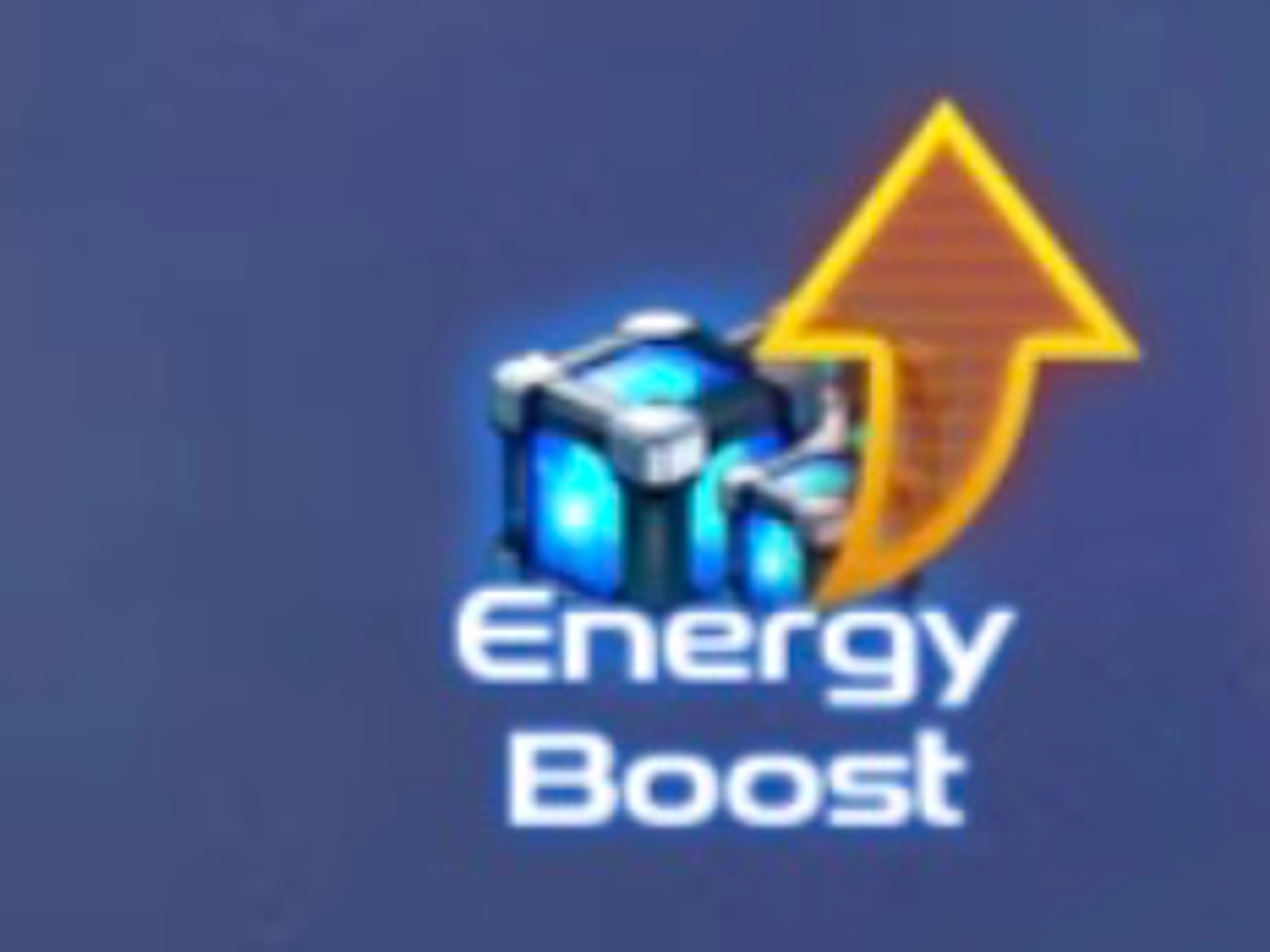
Energy acceleration is an energy mining acceleration activity launched by Cellula. It will work with multiple ecological partners at different stages to jointly launch a token reward plan. During the event, participating in energy mining can mine more energy rewards than usual when the computing power of the entire network is the same.
After the Cellula mainnet is launched, the first phase will start an accelerated mining airdrop event with BNB Chain, which will add an additional airdrop of 1,000,000 $CELL tokens to the basic mining reward. Please look forward to the launch of subsequent joint activities, and more and larger mining energy rewards will be launched.
Quests: Earn Social Points
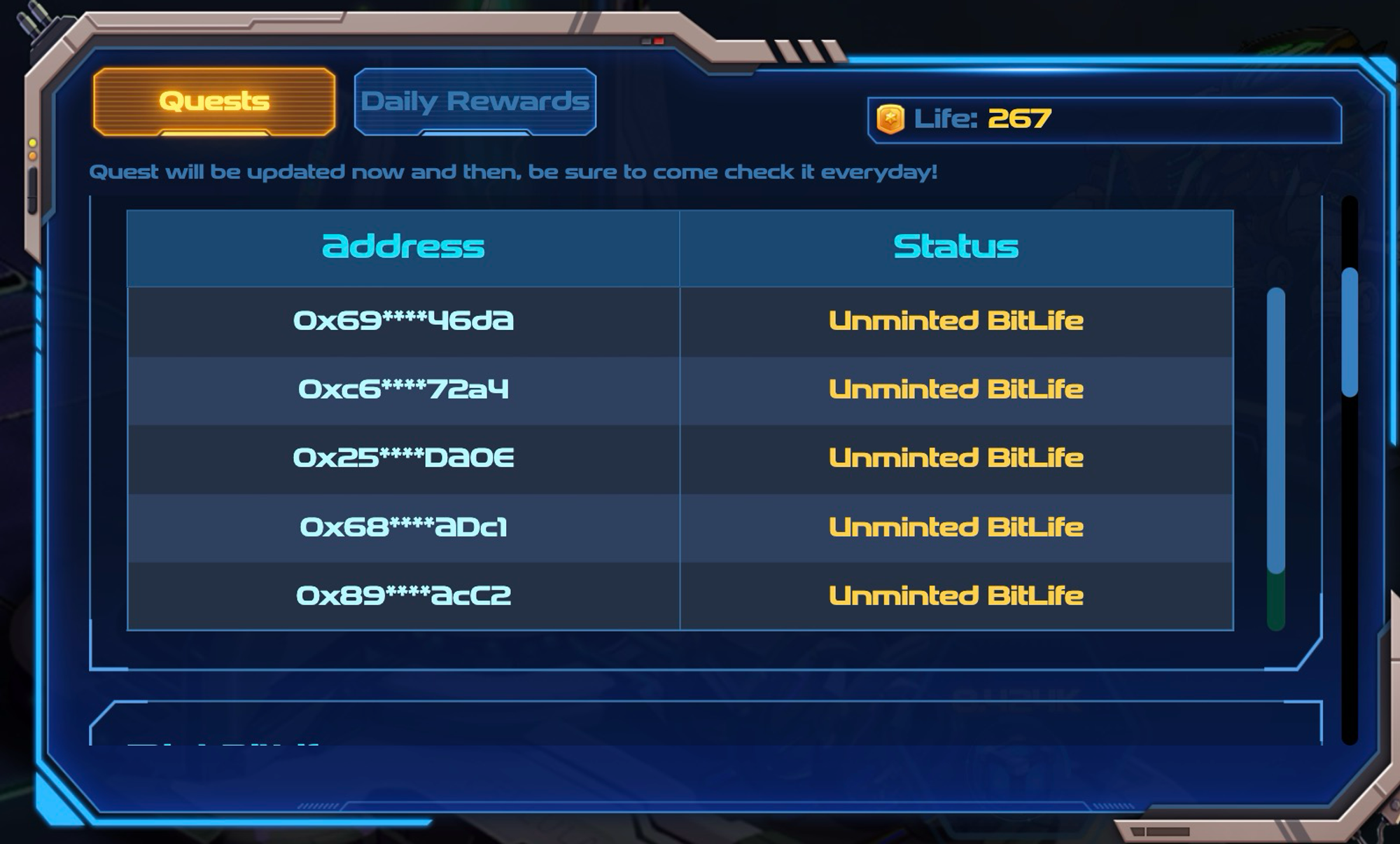
Cellula's mission platform is divided into two parts: missions and daily rewards.
The task is one-time, and you can receive generous energy rewards after completing the task. Cellula platform will release various tasks for everyone to challenge from time to time.
Daily rewards are tasks that can be completed every day. After completing them, you can also receive generous energy rewards. Daily rewards are refreshed every 24 hours. You can participate every day and get extra rewards.
Leaderboard:

Currently, the computing power rankings and popular BitLife rankings are online.
The computing power ranking list is the computing power ranking list of all users in the entire network, and the top 100 users will be displayed on the ranking list.
The popular BitLife rankings are based on the number of BitLife currently working in the mining pool. The top ranked BitLife are the ones with the most users, which represents their popularity in the community. This ranking can help you understand the most popular BitLife at the moment, and may provide you with some valuable references and choices.
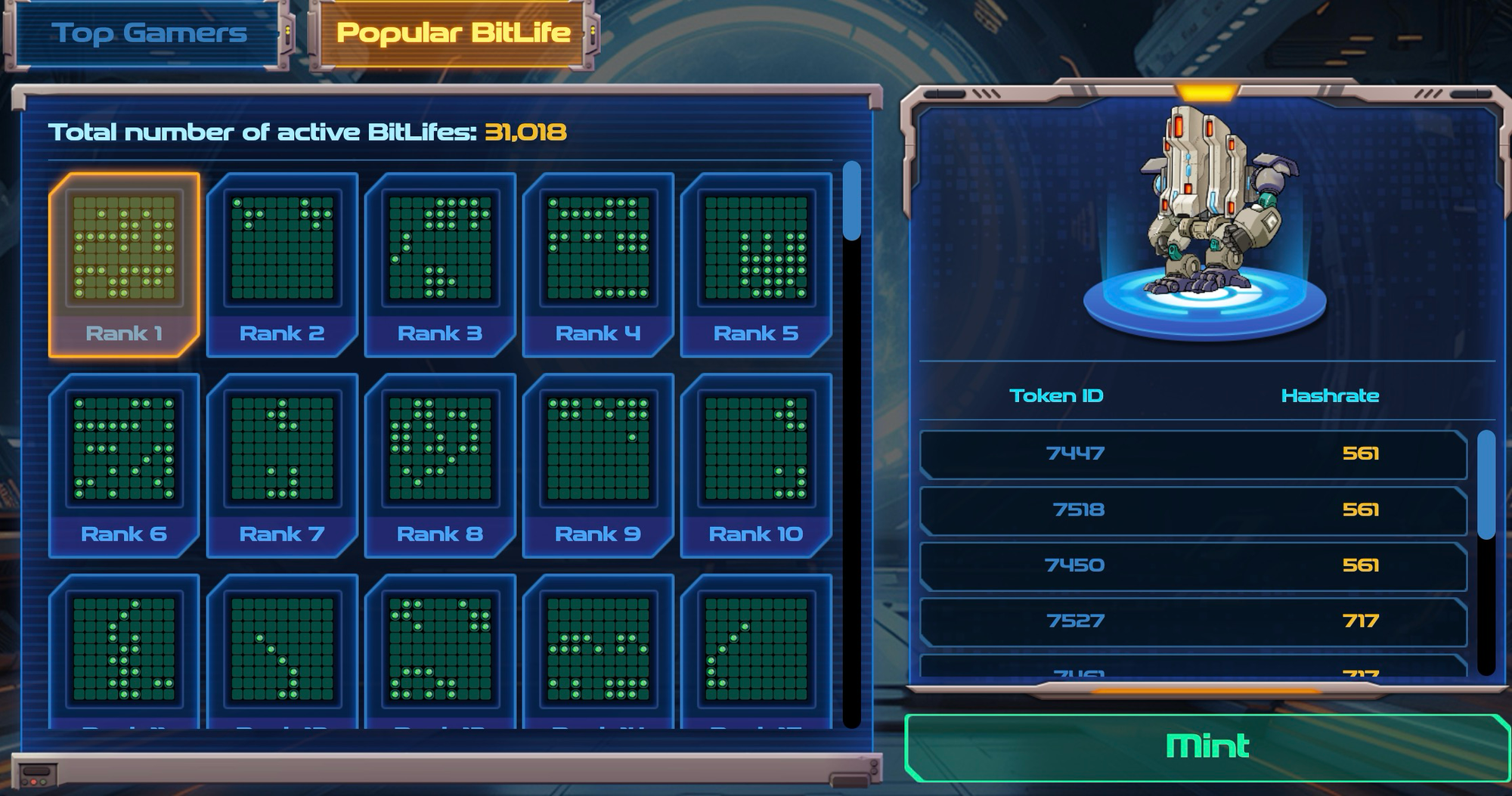
Team: Coming soon, team mining.
Charge
By charging BitLife, you can stimulate their actions and make them grow. As they grow, they actively collect energy and funnel it into your spaceship.
There are three types of charging, which last for 1 day, 3 days, and 7 days. Each type of charging has different prices and working hours. The price of charging for 1 day is 0.0017 BNB; the price of charging for 3 days is 0.0051 BNB; the price of charging for 7 days is 0.0119 BNB. (Calculated based on 1 BNB = 585 USDT, the corresponding charging prices are 1 USDT, 3 USDT, and 7 USDT respectively.)
Note that charging prices will not be adjusted frequently.
Recharge is not a prop or NFT, there is no concept of storage, and it can be used immediately after purchase. After using the charge, the working time of BitLife will be reset instead of accumulated. According to the mysterious merchant, there will be more types of charges in the future, with mysterious powers, so stay tuned.
Game numerical introduction:
Mining points energy:
Energy points represent the resources collected by your BitLife in Cellula. In the future, energy points will be used to obtain Cellula token airdrops. An energy cycle will be carried out every 5 minutes, and each cycle will generate 77,160.49 energy points (101,962.08 energy points per cycle during the BNB Chain event). These energies will be distributed according to the computing power of the BitLife currently mining. If your BitLife has a higher computing power, you will get more energy allocation.
Social Points Life:
Life represents your contribution to the Cellula ecosystem, and in the future, life points will also earn you Cellula tokens. Life points are mainly generated through the task system, and can be obtained by deeply participating in the experience of Cellula's functions and tasks in the task system.
BitLife Hashrate:
BitLife has an important unique ability, which is computing power. This computing power determines the distribution ratio of the energy produced in each energy cycle among BitLife. Only when BitLife is charged will its computing power be activated and included in the calculation range. The larger the computing power value of BitLife, the more powerful it is.
Cellula is very much looking forward to the launch of Game Of Life, the first game on the mainnet, and invites players from all ecosystems to experience mining with digital life and experience the different evolution of life and evolution on the life chain.
VRGDA issuance mechanism
Cellula uses a progressive Dutch auction. If the market demand for BitLife exceeds expectations, the forging fee will increase. If the demand is insufficient, the fee will decrease. When the demand is in line with expectations, the fee remains the same. In this way, the supply and demand balance of in-game assets can be cleverly achieved.
Preparation
Add BSC mainnet: https://chainlist.org/?search=BSC
Deposit BNB for gas.
Register a MyShell account: https://app.myshell.ai/invite/34a05c
Prepare an Excel spreadsheet: record the cost-effectiveness of the NFTs you purchased and your own investment.
Gameplay Details
Users can choose different identities to participate in the game: miners, market makers, mining machine (BitLife) issuers, NFT (BitCell) lessors, ordinary game players. Different roles generate dynamic multiple games with different behavioral strategies.
Here's how the average gamer's character starts playing the game.
- Go to the Cellula game page https://factory.cellula.life and start the game.

- First, enter the "BitLife Hub". You can directly purchase Top BitLife in the BitLife Shop, or you can synthesize your own BitLife in Mint BitLife.

In BitLife Shop, you can select different days of hashrate values to sort and filter your purchases. Choose the BitLife you like, and then mint it. There are a lot of things to pay attention to here. Many people don't understand this and spend more money, but the quality of the minted BitLife is average. You can read the following "Game Strategy for Purchasing: Strategies for Purchasing BitLife in the Store."
You can also rent different BitCells to synthesize your own BitLife. Drag any number of BitCells in the leftmost frame to the synthesis table in the middle, and then click mint. Click the fast forward button in the synthesis table, and the evolution table will appear. In the evolution table, you can drag the progress bar below to adjust the evolution speed. Generation represents the evolution generation, and Active Cell Now represents the number of active cells in the current generation. The number of active cells is the hashrate of the current BitLife.
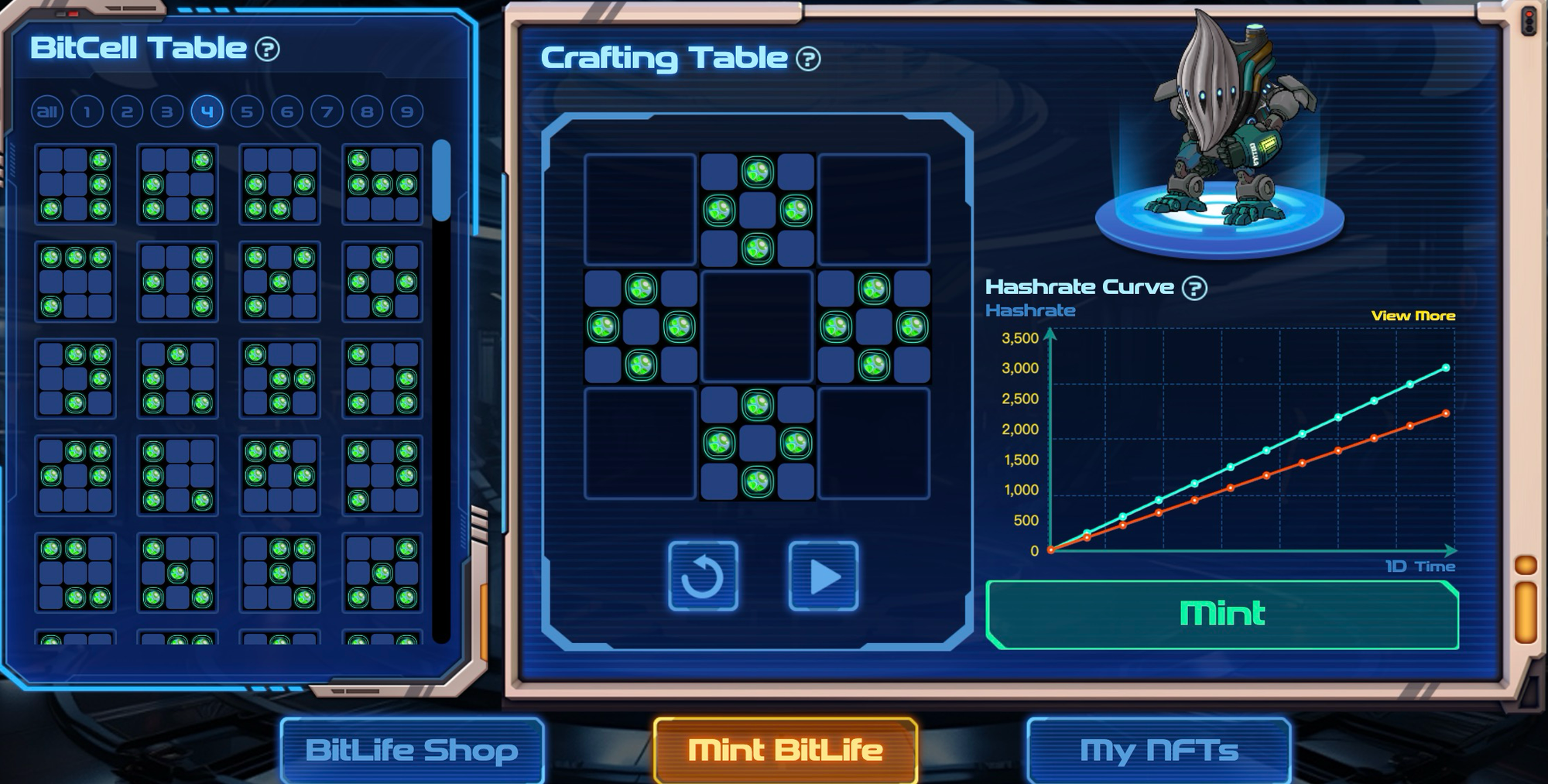
- Click the triangle arrow to open the Evolution Room. In the Evolution Room, you can drag the progress bar at the bottom to adjust the evolution speed. Generation represents the generation of evolution, and Active Cell Now represents the number of active cells in the current generation. The number of active cells is equivalent to the current computing power of BitLife.
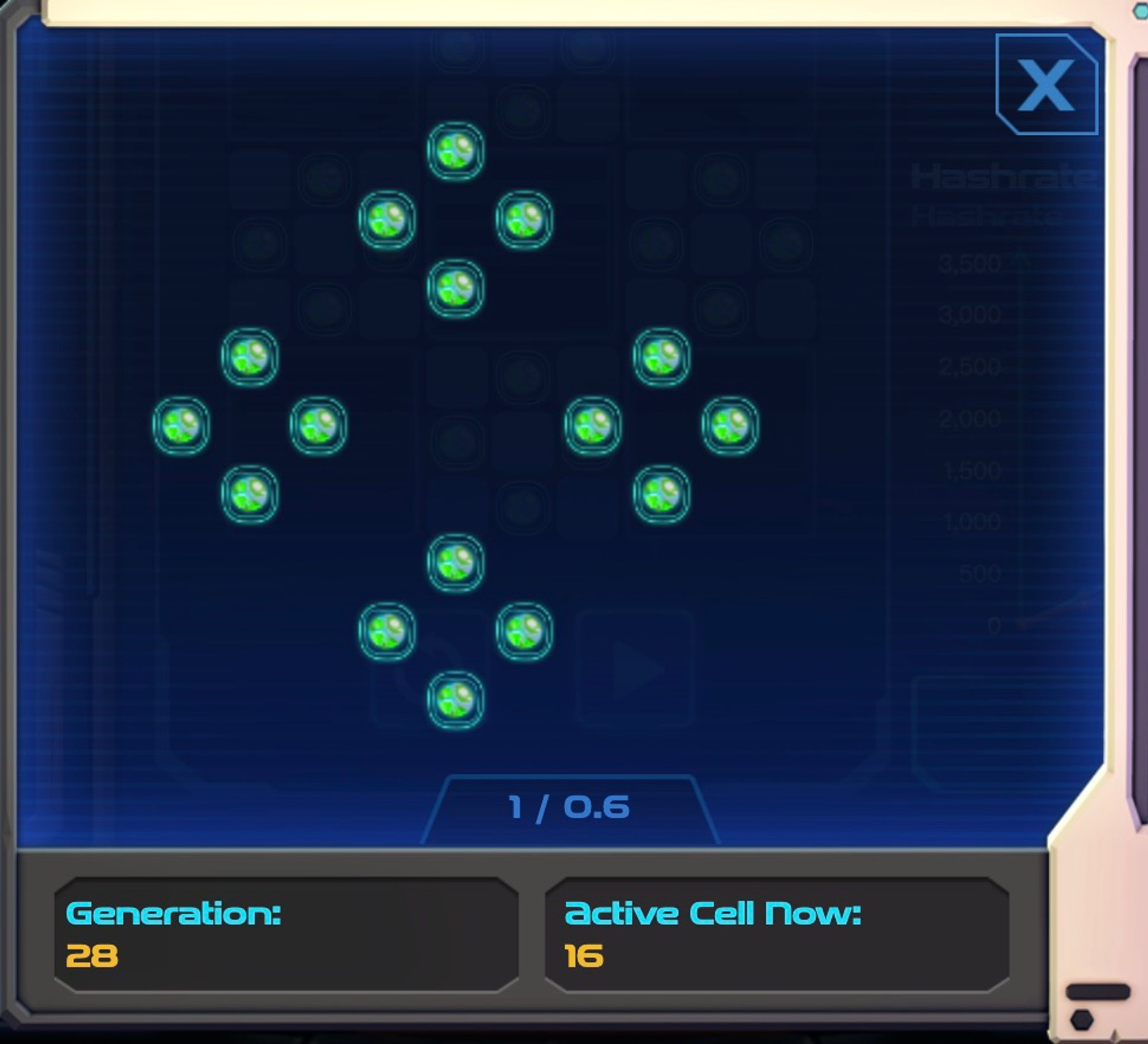
- In My NFTs, you can view the BitLife and BitCell you already own.

In My BitLife, you can see all the BitLife Energy and Hashrate details you have. In My BitCell, you can see the list of BitCells you hold and the staking income that can be withdrawn. (BitCell has not yet been released, remember to pay attention to the whitelist activities.)
Return to the main interface of the game, click the main building to pop up the BitLife list. You can charge the BitLife that is resting, and you can choose to charge it for different days of 1D/3D/7D. Energy can only be collected after charging is successful, and the energy income is updated every five minutes. (Charging days cannot be superimposed, so please do not charge the BitLife that is working repeatedly.)
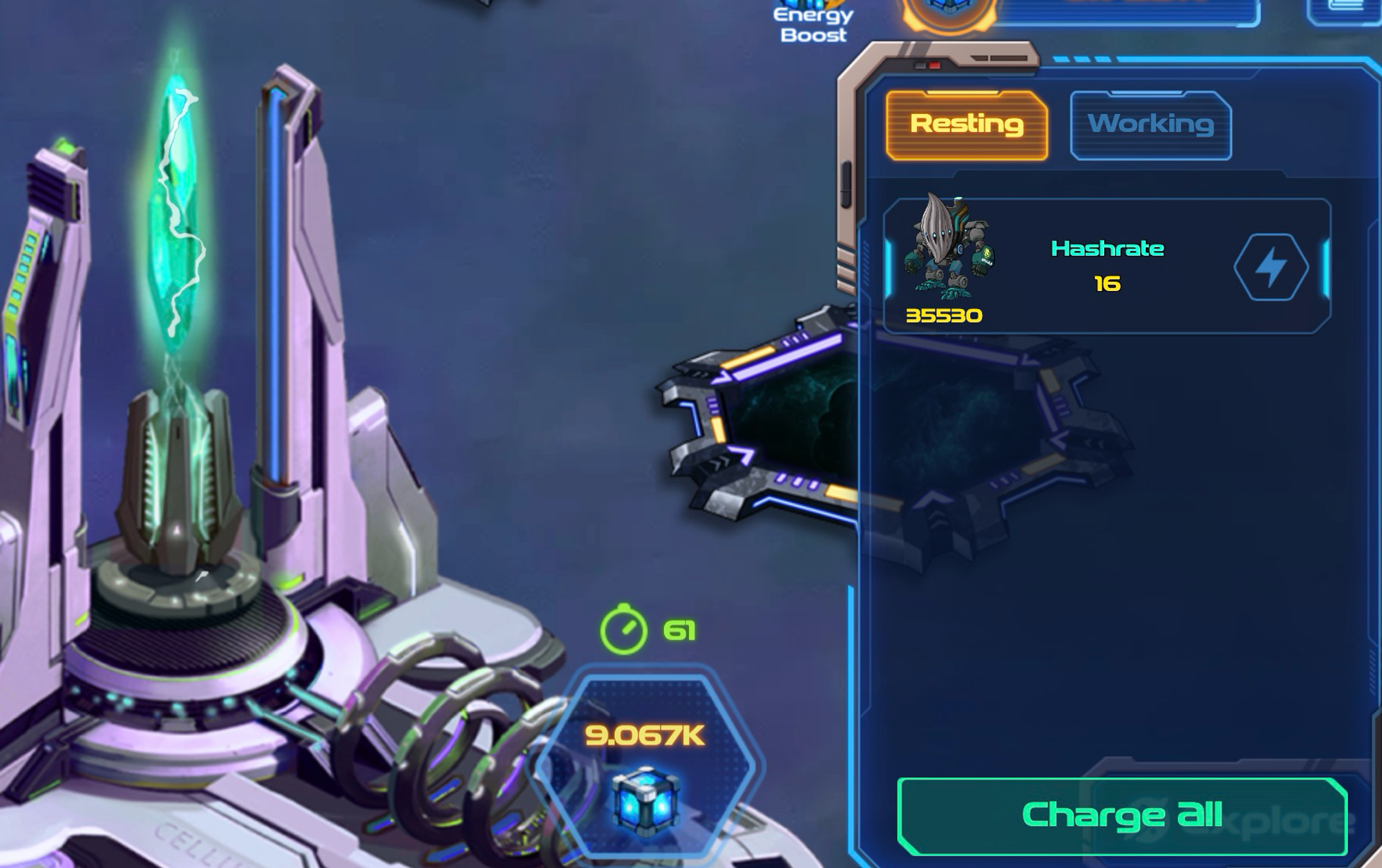

- Click the energy block in the main interface to collect the energy produced by the working BitLife in real time.

- This concludes the basic introduction to the gameplay of the entire game, which is basically about having your own BitLife, charging it, and letting it work, over and over again.
How to increase mining energy points
- Purchase high hashrate BitLife in the BitLife Shop to increase your Energy income quickly and easily.
- Find BitLife with high hashrate in Mint BitLife and formulate different strategies according to the rules of Conway's Game of Life .
3. Ensure that all BitLife are in Working state, use the one-click charging function, easy to use.
Energy Acceleration Activities
How to get social points Life
Enter the Quest task list in the main interface, and you can accumulate social points Life by completing different tasks. Regular tasks include but are not limited to (inviting friends, casting BitLife, increasing computing power (casting more BitLife & charging BitLife will increase computing power); Twitter naming activities.
In daily activities, users can obtain different social points by collecting Energy points, casting new BitLife every day, charging BitLife, sharing games, etc.
How to view relevant data
Leaderboard
Top Gamers: In the Top Gamers data panel, you can see My Hashrate, Hashrate bonus coefficient, and network ranking. It also displays the unclaimed Energy income record, which is updated every five minutes.
Popular BitLife: In the Popular BitLife data panel, you can see the genotype ranking of synthesized BitLife.
Game Points
1. The total personal energy points will be displayed in the upper right corner of the main page.
2. The total points of your personal Life will be displayed on the Quest page.
Game Strategy: Purchasing
To sum up, it is about how to choose a cost-effective BitLife and complete a cost-effective charging plan. The rest is the problem of collecting energy on time.
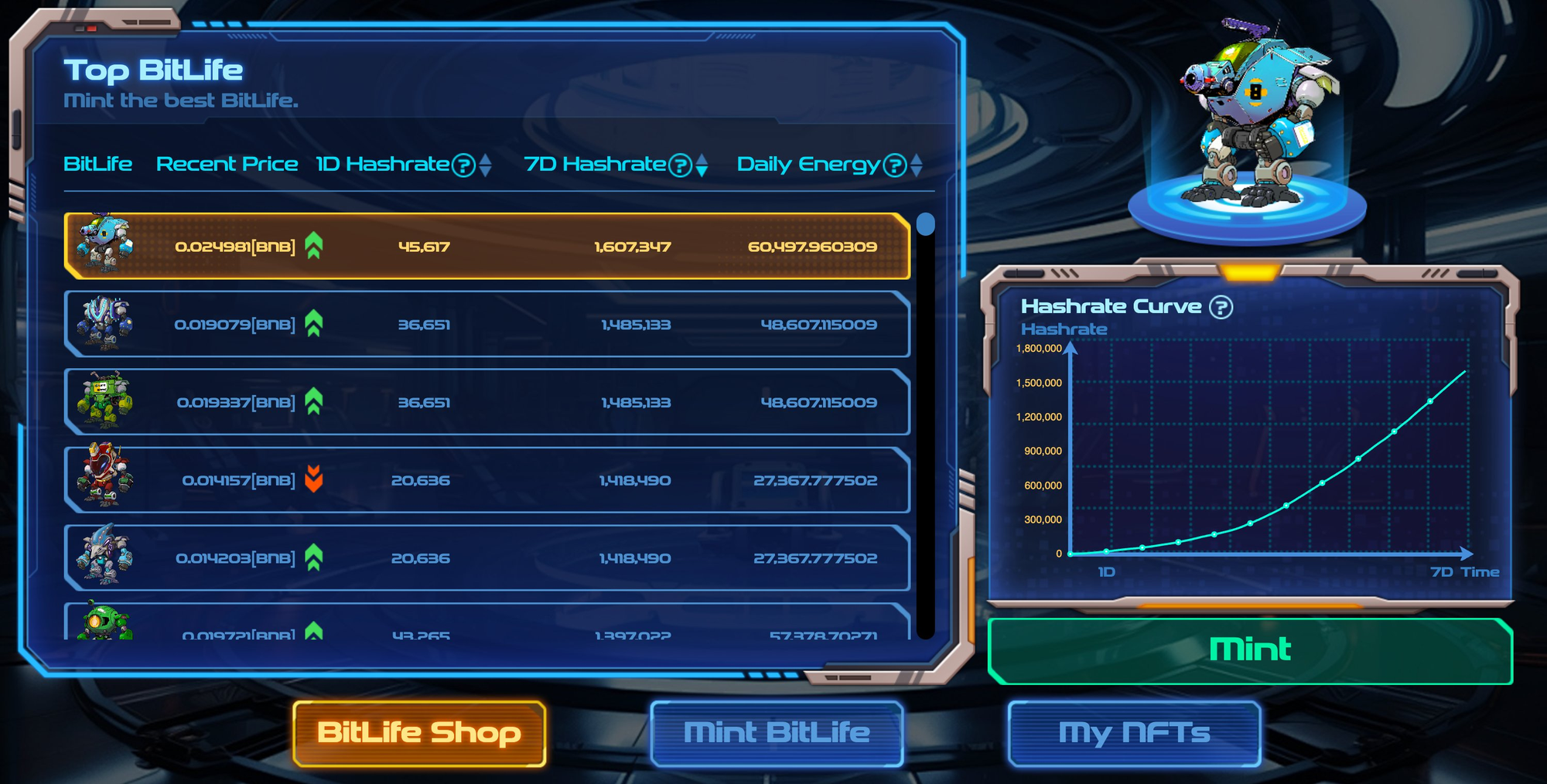
The marked price is controlled by the VRGDA (Variable Rate Gradual Dutch Auctions) model invented by Paradigm, which achieves the effect of progressive Dutch auction:
When the market heat exceeds expectations, the price rises; when the market heat is lower than expected, the price falls; and when the market heat is consistent with expectations, its price is equal to the set target price. (Green and red arrows)
My method is to make a table, record " price one day computing power one day computing power/price seven days computing power seven days computing power/price daily energy ", then search for 0.001, search upwards for +0.001, sort by "one day computing power/price + seven days computing power/price", and take the one with the right value directly.
Note: The same robot can be purchased repeatedly. If you think it is very cost-effective, you can buy it repeatedly.
For NFT selection, look at the hashrate curve. The higher the computing power, the higher the energy allocated.
The 7-day recharge is more cost-effective than the 1-day recharge.
One Generation = 5 minutes. The number next to it indicates the number of cells that are still alive. If the number of cells that are alive is zero, then this BitLife has no computing power. At least two BitCells are needed to synthesize a BitLife.
Get a cost-effective mining machine: Don’t rush to buy a mining machine with high computing power in a single day, which is not only expensive but also mostly weak in the later stage; combine the data of 1 day and 7 days to buy those that may have low computing power in the short term, but have great growth potential. Such mining machines are often very cheap. Mainly cheap + relatively high computing power.
Charging: You can get social points for the first three charges each day, so don't charge a 7-day battery at once. You can charge a 3-day and a 7-day battery every day, and charge the rest for 1 day.
Maximizing computing power: Mining machine attributes and time are the two most important factors. Even if some mining machines have poor attributes, the growth rate brought by the long iteration time is also considerable. The benefits of two general computing power cells may far exceed that of a super computing power cell, but the price will be much cheaper.
Game strategy: self-generation
The essence of this game is to generate your own BitLife. The premise of generating high-quality BitLife is to fully understand Conway Life. In simple terms, the Conway Life rule is that cells cannot be too close together, otherwise they will die due to resource competition, and they cannot be too isolated, otherwise they will die due to lack of cooperation.
Different combinations will generate different hashrate lifespans for different robots. Some will eventually decrease to zero, while others will stabilize at a certain value. Our goal is to generate a stable and high hashrate robot with as few materials as possible.
Rules of the game:
In the Game of Life, for any cell, the rules are as follows:
Each cell has two states - alive or dead. Each cell interacts with the eight cells around it (black for alive, white for dead).
When the current cell is alive, when the number of surrounding alive cells is less than 2 (not including 2), the cell becomes dead. (Simulating a scarce number of lives)
When the current cell is alive, when there are 2 or 3 alive cells around it, the cell remains as it is.
When the current cell is alive, when there are more than 3 alive cells around it, the cell becomes dead. (Simulation of too many lives) When the current cell is dead, when there are 3 alive cells around it, the cell becomes alive. (Simulation of reproduction) The initial cell structure can be defined as a seed. When all cells in the seed are processed by the above rules at the same time, the first generation of cell graphs can be obtained. Continue to process the current cell graph according to the rules to obtain the next generation of cell graphs, and repeat over and over again.
Proven stable state:
- You can see the introduction in https://zh.wikipedia.org/wiki/Conway's Game of Life : Conway's Game of Life.
Several placement methods
Imitation: Go to Leaderboard—Popular BitLife and see how the experts place it, and then copy it.
Design it yourself: I used MyShell to design a "Conway's Game of Life" bot. You can ask questions and let it generate configurations for you. Link: https://app.myshell.ai/bot/6bUziy/1713686136. It should be noted that for some reason, the configuration generated by this GPT may not be 100% the best configuration in Cellula, so you can try more and see how to configure it. The registration link for MyShell is: https://app.myshell.ai/invite/34a05c
Cellula Economic Model
The official economic model has not yet been made public.
How to avoid a death spiral?
In the Web3 gaming space, one of the issues players often complain about is that the Ponzi-based economic system can quickly decay and enter the so-called "death spiral." However, the Cellula game avoids this problem by cleverly introducing a distribution mechanism called VRGDA.
The mechanism uses a step-by-step Dutch auction method. This means that if the market demand for BitLife exceeds the initial forecast, the forging cost will increase accordingly. Conversely, if the demand is low, the cost will be reduced. Only when the market demand is in line with expectations will the fee remain stable. In this way, Cellula can effectively achieve a balance between the supply and demand of game assets.
Q&A
Q: I have a question. To claim the airdrop, you must claim Galaxy's level 3 OAT. Do we also have to claim level 1 and level 2 OAT to claim level 3 OAT? Can we directly participate in the event, mine, and then claim Level 3 OAT?
A: Those three OATs are independent, and you can do the third one directly.
Q: The third OAT must be collected on the 29th. Can it be collected later?
A: Yes, it will be available for collection on the 29th and will last for a while. Remember to collect all the energy before the snapshot.
Q: Do I have to claim Galaxy OAT to get the airdrop?
A: Yes, the airdrop targets OAT holders.
Q: How to claim Level 3 (Mainnet Alpha) OAT?
A: Snapshot on April 28, claims open on April 29
Q: Why does my ranking keep changing?
A: The hashrate of each BitLife is changing, which is a variable. The hashrate of the entire network is also changing, which is also a variable. Both the numerator and the denominator are changing.
Q: How is the double energy distributed?
A: During the BNB Chain activity, 101,962.08 energy points will be generated per cycle (five minutes). These energies will be distributed according to the computing power of BitLife currently being mined.
Q: Do I need to keep the game page open? Can I still mine after closing the page?
A: No need to keep it on all the time
Q:How often can I collect energy?
A: Energy will not disappear, you can collect it every few days. Energy will not be reset to zero if you don’t collect it. If you want to save gas fees, you can collect it every few days, but it is best to collect it all before the snapshot on the 28th.
Q: Daily Energy refers to the data for the day, that is, the first day, right?
A: Yes
Q: Does charging it over 7 days produce the same benefits as charging it all at once for 7 days?
A: Same. Daily reminder: Remember to collect all the energy before taking a snapshot.
Q: Do I need to charge my newly minted Bitlife right away? Otherwise I won’t be able to use it?
A: Yes, charge it immediately.
Q: Can charging time be added up?
A: No, the new charging package will cover the old one, so don't buy multiple at a time, just buy one.
Q: When charging for a day, does it count from the beginning of the 24 hours, or does it expire at 0:00 on the same day?
A: 24 hours from the start of charging.
Q: The rules are too complicated, please give me a suggestion on how to buy it? The simplest one.
A: Buy the ones that are ranked high in the store and then compare the daily energy benefits and prices to see which one offers the best value for money.
Q: What is Bitlife's daily energy and what is its function? Is it generated or consumed?
A: Mining income and mining points Energy: Energy points represent the resources collected by your BitLife in Cellula. In the future, energy points will receive Cellula token airdrops. An energy cycle will be carried out every 5 minutes, and each cycle will generate 100 energy points. This energy will be distributed according to the computing power of the BitLife currently mining. If your BitLife has a higher computing power, you will get more energy allocation.
Q: How do you tell whether a robot is alive or dead?
A: When the computing power reaches zero, it is "dead". Click the play button before synthesis to see whether it is stable or zero at the end. Reference: https://en.wikipedia.org/wiki/Conway's_Game_of_Life This depends on the number of active cells: If the number of active cells stabilizes at 50 after a certain generation (for example), then it is immortal. If the number of active cells becomes zero after a certain generation, it is "dead".
Q: As long as the cells are there, they will not die. No matter how many generations there are?
A: Absolutely correct
Q: How can I tell if the ones I buy from the store will die?
A: Only those who have synthesized it themselves can see the deduction (data after seven days), but those who can be put on the store are generally very powerful.
Q: If someone else buys my design, will I get any profit?
A: Not yet
Q: I designed it myself, why is the miint fee so high?
A: The fee depends on the total price of BitCell.
Q: Is BitLife's computing power permanent? Why does it sometimes increase and sometimes decrease?
A: It changes dynamically. As the usage time increases, some may drop to zero, while others may stabilize at a certain value.
Q: Why does the price of electricity change?
A: Because the price of BNB is changing, the electricity price in BNB is also changing, but the electricity fee is anchored at $1/day.
Q: I forgot to charge my BitLife. Will the hashrate be reset when I charge it again?
A: It will not be reset. The hashrate will continue from where it ended last time.
Q: What does it mean that BitCell has a profit?
A: BitCell holders will receive a share of the minting profits. BitCell NFT has not yet been issued. If someone rents your BitCell, you will receive a share. This NFT has not yet been issued.
Q:What is the approximate HashRate for a combination to be considered good?
A: You can refer to the price and computing power of the top-ranked BitLife in the store to see if you have an advantage over them if you choose to synthesize it yourself.
Q: What is the use of the social point “Life” in the upper right corner?
A: It will be enabled in the future, please pay attention to the announcement.
Q: What is the countdown on BitLife for?
A: The energy will be updated after the countdown ends.
Q: Does charging require 3 days first and then 7 days?
A: It's OK. Just remember to charge after the battery is used up. Charging is not cumulative, it is a refresh. The new charging package will overwrite (refresh) the old package and will not be accumulated.
Q: Will the synthesized/purchased BitLife disappear?
A: No, it will always be in your account.
Q:Will the energy be reset to zero if it is not claimed?
A: No, you can get it once a day or every few days.
Q: Why does the price of electricity change?
A: Because the price of BNB is changing, the electricity price in BNB is also changing, but the electricity fee is anchored at $1/day.
Q: I forgot to charge my BitLife. Will the hashrate be reset when I charge it again?
A: It will not be reset, the hashrate will continue from where it ended last time.
Q: Is BitLife’s computing power permanent?
A: It changes dynamically. As the usage time increases, some may drop to zero, while others may stabilize at a certain value.
Q: Do I have to claim Galaxy OAT to get the airdrop?
A: Yes, the airdrop targets OAT holders.
Q: How to claim Level 3 (Mainnet Alpha) OAT?
A: Snapshot on April 28, claims open on April 29
Q: What are the rules for charging packages? Can the days be accumulated?
A: The new charging package will cover the old package and will not be accumulated.
Q: How much energy will be generated during the event?
A: During the BNB Chain activity, 101,962.08 energy points will be generated per cycle (one cycle every five minutes)
Q: What do the red and green lines mean?
A: New: The cumulative number of active cells in the current combination, Old: The cumulative number of cells in the previous combination, 185: The hashrate value at this position. The green line is as high as possible, and this combination is better. Click [View More] in the upper right corner of the curve to see the changes in the values over the past seven days.
Q:What is the total amount of tokens?
A: Wait for the official announcement.
Q: In Galaxy Mission 3, what does Cellula Mainnet Alpha Participant refer to?
A: Those users who are currently participating in mining.
Q: Mr. Lou, please tell me why some 1d and 7d hashrates are relatively high. I think the daily energy is not as high as the low hashrate.

A:
References
https://en.wikipedia.org/wiki/Conway's Game of Life : Conway's Game of Life.
https://medium.com/@cellulalifegame/how-to-mine-with-digital-life-in-cellula-ecd5aee9d5dc
risk warning
The above is just a game guide and does not constitute investment advice.
Contact the author
Twitter: https://twitter.com/wang_xiaolou
TG: @rigongyizuwangxiaolou
WeChat community: add assistant WeChat jieyouduola, note day by day






